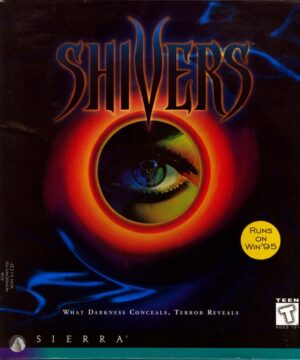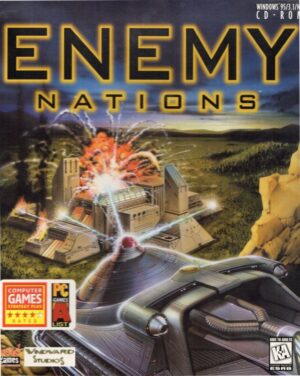Retro Replay Review
Gameplay
Warhead takes the classic Missile Command formula and injects it with intense, fast-paced action. Players are tasked with defending a row of cities against relentless waves of incoming warheads, planes, and smart bombs. Each of your two missile bases is mapped to a different mouse button, encouraging a delicate dance of cursor movement and timely clicks to foil enemy advances. The simple control scheme belies the depth of coordination required: you’ll need to switch targets swiftly while keeping an eye on ammunition reserves and the health of both bases.
One of the game’s strongest hooks is its resource management component. Ammunition is limited, so every shot must count. Waste too many projectiles on a harmless cloud of debris, and you might find yourself helpless when a real threat closes in. Combined with the possibility of having bases destroyed, Warhead demands a blend of quick reflexes and strategic restraint. Should you concentrate fire to preserve cities on one side, or split your defenses evenly at the risk of neglecting one flank? These decisions keep each playthrough gripping and tense.
Progression in Warhead is measured by escalating difficulty rather than a sprawling campaign. As you master the basics, the incoming assaults grow more sophisticated: smart bombs that adjust their flight paths, swarms of planes that dive in unpredictable formations, and the relentless rain of warheads that test your stamina and cunning. The balance between frantic survival and calculated targeting makes for a satisfying challenge, whether you’re aiming for a personal high score or simply trying to stave off nuclear apocalypse a little longer.
Graphics
Graphically, Warhead embraces a clean and functional aesthetic. The visuals are reminiscent of arcade classics, with bold, easily distinguishable sprites for incoming threats and defensive missiles. Explosions are rendered as bright, expanding circles that momentarily light up the screen, giving each successful intercept a tangible sense of impact. There’s an undeniable charm in the minimalism, where form follows function and every pixel serves a gameplay purpose.
While it doesn’t boast photo-realistic textures or cutting-edge particle effects, Warhead’s presentation is more than adequate for its style. The color-coded missiles and projectiles immediately convey threat levels and origins, allowing you to make split-second targeting decisions. Backgrounds remain unobtrusive, often a dark canvas that lets the vibrant missile trails and explosions take center stage without visual clutter getting in the way.
Animations are smooth and responsive, from the missile arcs traced across the sky to the crumble of a destroyed base. Subtle visual feedback—like flashes when a city is hit—adds to the emotional stakes, reminding you of the stakes without resorting to lengthy cutscenes or dialogue. In a genre where clarity is king, Warhead nails the essentials and keeps the action unencumbered.
Story
Warhead doesn’t spin an epic narrative with branching paths or cinematic cutscenes, yet it crafts a compelling framework through its simple premise. The world stands on the brink of nuclear conflict, and you are the last line of defense. Each wave of incoming ordnance represents another step toward global devastation, and it’s up to you to salvage what remains of civilization. In this sense, the story unfolds organically through gameplay rather than scripted exposition.
Though background lore is minimal, Warhead taps into the visceral tension of Cold War–style scenarios, where a single missed shot can mean catastrophe. This barebones approach allows the game to focus squarely on the immediacy of defense, immersing you in an atmosphere of high stakes and rapid decision-making. The sense of dread comes from the ticking timers and the growing crescendo of enemy fire, not from lengthy dialogue or lore dumps.
Where the narrative is sparse, the audio design steps in to fill the gap. Warning sirens, the rumble of incoming missiles, and the thunderous booms of explosions all convey urgency and stakes. It’s a testament to how a game can use minimalist storytelling—relying on player imagination and environmental cues—to craft a compelling scenario without a sprawling storyline.
Overall Experience
Warhead delivers a tightly focused, adrenaline-pumping experience that will appeal to fans of arcade-style defense games and score chasers alike. Its straightforward controls and escalating challenge make it accessible to newcomers, yet the depth of strategy and quick reflex demands provide plenty of room for mastery. Each attempt feels consequential, whether you’re saving your last missile for a critical intercept or scrambling to protect the last standing base.
The game’s brevity is both a strength and a limitation. Sessions are short, often ending in spectacular fashion as bases crumble under a hail of smart bombs. This makes Warhead an ideal pick-up-and-play title for those who want a quick thrill, though players seeking a sprawling campaign or narrative-driven adventure may find it lacking. Still, the high replay value lies in improving personal records and perfecting defensive strategies against ever-more vicious enemy patterns.
Ultimately, Warhead proves that simplicity can be incredibly compelling when executed with precision. It doesn’t try to be everything at once; it hones in on the core satisfaction of intercepting threats and protecting cities under siege. For anyone craving a modern take on the timeless Missile Command concept—complete with strategic depth, responsive controls, and relentless pacing—Warhead is a strong choice that defends its premise with explosive flair.
 Retro Replay Retro Replay gaming reviews, news, emulation, geek stuff and more!
Retro Replay Retro Replay gaming reviews, news, emulation, geek stuff and more!






Reviews
There are no reviews yet.